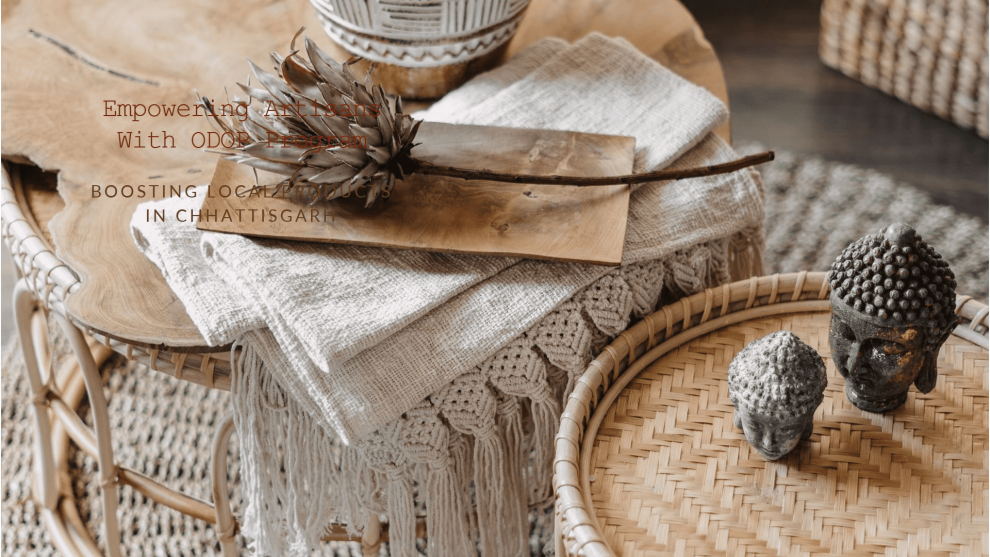The One District One Product (ODOP) initiative in Chhattisgarh is a transformative effort aimed at promoting the unique and traditional products of each district. Introduced as part of the broader framework of India’s AatmaNirbhar Bharat Abhiyan, this program has proven to be a powerful tool for fostering local economies, empowering artisans, and uplifting rural communities in the state.
The Essence of ODOP
The ODOP program focuses on identifying one specific product from each district that has significant market potential, cultural relevance, or economic importance. By promoting these products, the initiative aims to:
- Enhance Employment: Create job opportunities, especially for rural artisans, weavers, and small-scale entrepreneurs.
- Boost Exports: Increase the visibility and marketability of local products in national and international markets.
- Preserve Culture: Protect and promote traditional crafts, techniques, and heritage.
ODOP Implementation in Chhattisgarh
Chhattisgarh, with its diverse culture and abundant natural resources, has embraced the ODOP initiative wholeheartedly. Each district has been assigned a product, backed by state-supported marketing, infrastructure development, and capacity-building programs.
Highlighted ODOP Products in Chhattisgarh
Chhattisgarh’s ODOP program encompasses a diverse range of products that reflect the state’s cultural heritage, natural resources, and traditional craftsmanship. Here’s a detailed district-wise list of ODOP products:
- Raipur – Kosa Silk
Known for its premium quality, Kosa silk from Raipur is a hallmark of luxury textiles. The district’s artisans are renowned for producing sarees, dupattas, and other garments with intricate designs and vibrant colors. - Bastar – Wrought Iron Craft
Bastar’s tribal art is legendary, with wrought iron products like decorative items, statues, and utility items gaining national and international acclaim. - Durg – Bamboo Handicrafts
Bamboo products from Durg include eco-friendly furniture, baskets, and decorative items. These are popular for their durability and sustainable nature. - Bilaspur – Handloom Weaving
Bilaspur’s handloom industry is famous for its soft and colorful textiles, including sarees, dress materials, and bedsheets. - Kanker – Organic Spices
Known for turmeric, ginger, and other organic spices, Kanker has emerged as a hub for high-quality, chemical-free products. - Rajnandgaon – Bell Metal Crafts
Rajnandgaon specializes in bell metal products such as decorative figurines, utensils, and ornaments crafted by skilled artisans using ancient methods. - Korba – Lac Products
Korba’s lac bangles and decorative items are in high demand for their vibrant colors and craftsmanship. - Dhamtari – Paddy and Rice-based Products
As a major rice-producing region, Dhamtari offers unique rice-based snacks, flour, and other products. - Jagdalpur – Tribal Jewelry
Traditional jewelry made of beads, stones, and metals from Jagdalpur is a true reflection of tribal artistry. - Surguja – Minor Forest Produce (MFP)
Surguja is known for tamarind, mahua, and honey. These natural products are collected and processed by tribal communities. - Jashpur – Tea
Jashpur’s tea plantations produce high-quality organic tea that has gained popularity in domestic and international markets. - Balod – Soya Products
Balod focuses on soya bean farming and the production of soya-based food items like tofu and soya milk. - Mahasamund – Tribal Wooden Crafts
Wooden artifacts such as toys, furniture, and utensils from Mahasamund are prized for their durability and aesthetic appeal. - Koriya – Herbal Products
Koriya is a hub for medicinal herbs like amla, ashwagandha, and giloy, which are processed into powders, tablets, and oils. - Balodabazar – Marble Products
Balodabazar is famous for its marble-based statues and decorative items, reflecting the skill of local artisans. - Bemetara – Pickles and Murabba
The district is known for its fruit-based pickles and murabba (preserves), crafted using traditional recipes. - Gariaband – Cashew
Cashew nuts from Gariaband are processed and packaged locally, ensuring freshness and quality. - Kabirdham – Baiga Art
The Baiga tribal art from Kabirdham is a unique form of painting and craftwork that celebrates local mythology and traditions. - Sukma – Tendu Leaf Products
Sukma produces tendu leaves used in making traditional cigars (bidis) and eco-friendly products. - Narayanpur – Dokra Art
The intricate and unique Dokra metal casting from Narayanpur is an ancient craft with global appeal. - Bijapur – Mahua-based Products
Mahua flowers are used in making syrups, candies, and health drinks that are traditional and eco-friendly. - Kondagaon – Terracotta
Kondagaon is famous for its terracotta art, which includes figurines, pots, and decorative items crafted from locally sourced clay. - Sarangarh-Bilaigarh – Khadi Products
The district promotes khadi textiles and garments, ensuring the preservation of Gandhian traditions and employment for local weavers. - Gaurela-Pendra-Marwahi – Herbal Tea and Medicinal Plants
The region produces high-quality herbal teas and medicinal plants used in Ayurveda and natural healing. - Manendragarh-Chirmiri-Bharatpur – Coal-based Handicrafts
The district is innovating by creating coal carvings and handicrafts, reflecting the area’s mining heritage.
Key Strategies of ODOP in Chhattisgarh
- Infrastructure Development:
Establishing Common Facility Centers (CFCs) equipped with modern machinery for processing and packaging local products. - Financial Support:
ODOP artisans and entrepreneurs can access government subsidies, loans, and grants under programs like the PM Formalization of Micro Food Processing Enterprises (PMFME). - Market Linkages:
Partnering with e-commerce giants such as Amazon and Flipkart to showcase Chhattisgarh’s ODOP products on global platforms. - Skill Development and Training:
Regular workshops are conducted to enhance traditional techniques while integrating modern practices. - Branding and Promotion:
ODOP products from Chhattisgarh are promoted through trade fairs, exhibitions, and digital campaigns, highlighting their uniqueness.
Success Stories from Chhattisgarh
- Bastar’s Iron Art in Global Markets: Local artisans from Bastar have seen a rise in export orders due to better visibility and demand for sustainable decor items.
- Revival of Kosa Silk: Raipur’s Kosa silk industry, once struggling, now thrives as weavers receive steady orders and government support for raw material procurement.
Challenges and the Way Forward
While the ODOP program in Chhattisgarh has achieved significant milestones, challenges like limited awareness, logistical barriers, and competition from machine-made products remain. To address these, the state government is working on:
- Strengthening transportation and warehousing facilities.
- Increasing the number of artisan cooperatives.
- Enhancing digital literacy among rural entrepreneurs.
Conclusion
The ODOP program in Chhattisgarh has successfully combined tradition and innovation, enabling the state’s artisans to carve a niche in the competitive market. By continuing to invest in this initiative, Chhattisgarh is setting an example for inclusive growth and rural empowerment, while ensuring that its rich cultural heritage remains alive for generations to come.
Each district in Chhattisgarh has a unique product under the ODOP program, showcasing the rich cultural, natural, and industrial diversity of the state. By leveraging this initiative, Chhattisgarh is not only boosting local economies but also preserving traditional crafts and empowering communities at the grassroots level.
For more information or services related to MSMEs in Chhattisgarh:
📧 Email Us:
contact@entrepreneur.org.in
sharma.maayank@yahoo.com
📞 Call Us:
+91 97551 29633
🌐 Visit Us for Updates:
BharatiyaMedia.com
We’re here to support your entrepreneurial journey!












Add Comment